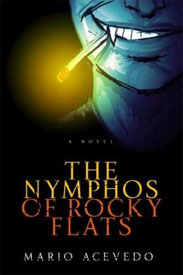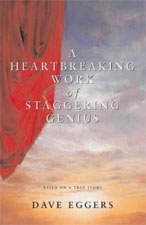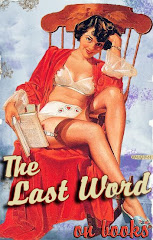 I'm always trying to find a book to read that strikes me as different than anything I've read before. When I saw a snippet about Demon Theory, it fit the bill nicely. It's written in three parts, and presented as a screenplay treatment; full of direction and camera angles and even footnotes.
I'm always trying to find a book to read that strikes me as different than anything I've read before. When I saw a snippet about Demon Theory, it fit the bill nicely. It's written in three parts, and presented as a screenplay treatment; full of direction and camera angles and even footnotes.What is there to say about a book which at one point has a character inject creamed corn into another characters brain by syringe? Perhaps "strange" and "weird" would work, but it's more than that. It's campy, sometimes silly, and chock full of pop culture references that it gets a little distracting.
The fact of the matter is, I wanted this book because I know a friend who options books to have made into movies. I thought to myself, what better movie from a book than a book written like it's three movies?
This novel, written by Stephen Graham Jones, begins easily enough. It's Halloween and med student Hale gets an odd phone call from his diabetic mother, and fearing that she hasn't been taking her insulin, Hale and five friends head out to the house he grew up in to check on his mother. That's the last time the book made complete sense to me for the next 265 pages--until part three.
Demon Theory is written from the perspective of a doctor in a mental institution, created from the notes he transcribed during a patient interview to be made into a movie called "The Devil Inside" (and two sequals). It has the usual slasher flick regulars--twenty somethings who think they know everything but don't know they're about to be slaughtered. There's the smart one, the stupid one, the reluctant hero, the slut and so forth. For the life of me I could not keep their names straight. All I can keep straight is that Hale is the one who grew up in the house, it's his mother who is missing, and he has a dead (I think ?) sister named Jenny. She either has no legs from a three-wheeler accident caused by Hale, or she has the legs but they're all chewed up and useless.
Con is the reluctant hero who runs away more often than sticks around and helps. He smokes. And part of his costume in part one is a prosthetic arm that by part three is actually his own prosthetic because he lost an arm in part two.
Then there's Nona. She was a med student in part one and a janitor recently out of the loony bin in part two. In part one she was dating Hale. But in part two Hale is only 14 and in a coma while she's the adult janitor. Part three comes around and they both sort of remember having a romantic relationship, but it's all fuzzy and slips out of view when they look for it straight on.
Confused yet?
Maybe my mind got so screwed up because of the footnotes. I think if you strung the footnotes end to end, they would have wrapped around the moon. Seriously. It was just ridiculous. Over 400 plus footnotes! So every third sentence in this 374 page book had a footnote. And the footnotes are not located on the bottom of the page for easy access, no--they are located in the back of the book for another 56 pages! Anyway, so I was flipping back and forth, reading the footnotes, then trying to get back into the story. Overkill.
Here's what I got: Hale is feeling guilty about the accident that happened when he was 14 and his sister was 10. They were out riding on the three-wheeler when Jenny's pant leg got caught on a wheel and she was pulled under. Hale didn't realize what happened right away and when he finally did, Jenny was all kinds of messed up, bloody and screaming. He picked her up and carried her home where she eventually gets planted in a wheelchair because she will never walk again. Well, while alive anyway.
Hale, throughout each part of the book, has flashbacks from different age perspectives, of the accident. So we get little pieces of the puzzle as we go. At one point we find out he tried to hang himself and either did or didn't succeed.
In Jenny's childhood room are charcoal drawings of angels and demons, large black wings and evil looking fang faces--picture a very large and icky gargoyle.
During part one when all the med student friends make it to the house, Hale's mother can't be found. Then a storm comes, then night falls, then the bloody bits begin. But who's behind it all? A man in a gargoyle mask that was orginally part of one of the med student's (Egan's) costume.
Let me take a moment to say that apparently Egan is also Nona's father, but in Part 1 he's the same age, and we only find out about this info in Part 3 when Nona drags everyone back to the house to "figure out" what happened and maybe save themselves.
Turns out the man in the mask is Hale's father who is completely off his nut and really wants to die, but Death doesn't want him. Go figure. Believe me, I'm not really giving anything away here, because bits and pieces are littered throughout the entire book, waiting for you to make sense out of it.
I don't want to say this book was crap really. The author has a catalog of obsessed knowledge in the footnotes about horror films and dialogue. I found myself trying to fight the urge to flip back to the footnotes but I couldn't stop myself. A few times I smacked myself because I really didn't need help knowing where "don't cross the streams" comes from (Ghostbusters) or that T1000 is the Terminator.
Perhaps if you can read the book straight through without giving in to the dreaded footnotes, you'll get a kick out of the book as slasher film. I've honestly never read a book like this but I'm thinking that maybe I should stick to the traditional format in order to keep my head from exploding.
What this comes down to is a bewildering trip through a flashback in a dream by a corpse who may or may not really be dead for the 4th time.
If you can figure it out, more power to you.
Click Here to Read More..
 The Nymphos of Rocky Flats by Mario Acevedo follows Felix Gomez as an Army veteran turned vampire turned private detective who has been hired by a former friend to investigate an outbreak of nymphomania at the Rocky Flats Plant in Colorado outside of Denver. During the environmental cleanup, a group of female employees encounter an unknown room and are exposed to a mysterious toxin that sends them off on a sexual rampage as they bang men like a screen door in a hurricane.
The Nymphos of Rocky Flats by Mario Acevedo follows Felix Gomez as an Army veteran turned vampire turned private detective who has been hired by a former friend to investigate an outbreak of nymphomania at the Rocky Flats Plant in Colorado outside of Denver. During the environmental cleanup, a group of female employees encounter an unknown room and are exposed to a mysterious toxin that sends them off on a sexual rampage as they bang men like a screen door in a hurricane.  A lot of people have read novels by Christopher Moore, mostly chatter about
A lot of people have read novels by Christopher Moore, mostly chatter about
 Major Rueben Malich, formerly in combat in the Middle East is sent stateside to attend university where he is enrolled in the courses of one Professor Averell Torrent. Unsure of what he was doing there but attentive nonetheless and taking notes in Farsi, he listens to Torrent and on occasion participates in verbal sparring. One great mind pitted against another. Arguing about Rome versus the United States. Absolute power. Revolution. World domination. Democracy. Race. The usual.
Major Rueben Malich, formerly in combat in the Middle East is sent stateside to attend university where he is enrolled in the courses of one Professor Averell Torrent. Unsure of what he was doing there but attentive nonetheless and taking notes in Farsi, he listens to Torrent and on occasion participates in verbal sparring. One great mind pitted against another. Arguing about Rome versus the United States. Absolute power. Revolution. World domination. Democracy. Race. The usual.

 Lucky for David, he happens to speak the Aramaic of 2000 years ago. Tom limps along on his rudimentary Hebrew. Thankfully, Tom remembers how to order beer in the right language.
Lucky for David, he happens to speak the Aramaic of 2000 years ago. Tom limps along on his rudimentary Hebrew. Thankfully, Tom remembers how to order beer in the right language.  When David discovered that Phoebe was handicapped, he handed her over to Caroline and instructed his nurse to take her to a home for mentally challenged kids, so she bundled up Phoebe & took off for the home.
When David discovered that Phoebe was handicapped, he handed her over to Caroline and instructed his nurse to take her to a home for mentally challenged kids, so she bundled up Phoebe & took off for the home. Meanwhile, the father, Norman, is confused by these people he is somehow related to, has no idea how to communicate with them, and Deirdre and he constantly go round for round screaming and shouting, culminating with the Deirdre accusing Norman of trying to kill her. So what does he do? Loses himself in booze.
Meanwhile, the father, Norman, is confused by these people he is somehow related to, has no idea how to communicate with them, and Deirdre and he constantly go round for round screaming and shouting, culminating with the Deirdre accusing Norman of trying to kill her. So what does he do? Loses himself in booze.  There’s a neighbor woman, Eileen Shears, with a dog, Wellington, down the street and this comes to the crux of the adventure. Christopher discovers the dog dead in Eileen’s front yard, stabbed by a pitchfork. Eileen discovers Christopher over the dog on the lawn and concludes it was Christopher that killed the dog. He didn’t though. But he liked the dog so decides he’s going to solve the murder of Wellington.
There’s a neighbor woman, Eileen Shears, with a dog, Wellington, down the street and this comes to the crux of the adventure. Christopher discovers the dog dead in Eileen’s front yard, stabbed by a pitchfork. Eileen discovers Christopher over the dog on the lawn and concludes it was Christopher that killed the dog. He didn’t though. But he liked the dog so decides he’s going to solve the murder of Wellington.  And so you have just a tiny bit of the crazy ass stuff going on in this week’s book, Plainclothes Naked by Jerry Stahl. Jerry Stahl is a former television writer, writing for shows such as CSI, Alf, Moonlighting, Northern Exposure and many more. He’s also written other novels, one being Permanent Midnight which was made into a movie starring Ben Stiller.
And so you have just a tiny bit of the crazy ass stuff going on in this week’s book, Plainclothes Naked by Jerry Stahl. Jerry Stahl is a former television writer, writing for shows such as CSI, Alf, Moonlighting, Northern Exposure and many more. He’s also written other novels, one being Permanent Midnight which was made into a movie starring Ben Stiller.  The Mayor of Pittsburgh, Marge, happens to be Manny’s ex-wife. The picture happened to have been nabbed by Tina, an employee of Seventh Heaven nursing home.
The Mayor of Pittsburgh, Marge, happens to be Manny’s ex-wife. The picture happened to have been nabbed by Tina, an employee of Seventh Heaven nursing home. 

 Frank McCourt pretty much recounts his childhood growing up in poverty. First in Brooklyn, but unable to find work, his father decides they should all go back to Limerick, Ireland. Except Frank’s father was a drunk who couldn’t hold a job. And when he did, he used any pay to go get a few pints instead of buy food for the family. Though this poverty didn’t stop him from repeatedly knocking up Angela, his wife.
Frank McCourt pretty much recounts his childhood growing up in poverty. First in Brooklyn, but unable to find work, his father decides they should all go back to Limerick, Ireland. Except Frank’s father was a drunk who couldn’t hold a job. And when he did, he used any pay to go get a few pints instead of buy food for the family. Though this poverty didn’t stop him from repeatedly knocking up Angela, his wife.  McCourt really did just lay it all out there; the good and the very bad.
McCourt really did just lay it all out there; the good and the very bad.  This is an autobiography. But there's more to it. It's charming and self-deprecating, and I thoroughly enjoyed reading every word—and by every word I mean every single word. See, I'm that person who actually looks on that one page with all the publishing info and Library of Congress filing position. To my surprise I found a not only a Kinsey scale pinpointing how straight/gay Eggers is but also other little informational tidbits.
This is an autobiography. But there's more to it. It's charming and self-deprecating, and I thoroughly enjoyed reading every word—and by every word I mean every single word. See, I'm that person who actually looks on that one page with all the publishing info and Library of Congress filing position. To my surprise I found a not only a Kinsey scale pinpointing how straight/gay Eggers is but also other little informational tidbits.  How does a person laugh at cancer? Or laugh at a friend who took a header off a balcony and ends up brain damaged? Or write that your own brother stinks like pee and you're worried that he's gonna be that kid in school who wreaks? Who decides that sending out a press release that Adam Rich, star of the old show Eight is Enough, is dead? Well, that would be Dave Eggers, the fella who thought that writing his life's story at age 29 was a good idea. Turns out he was dead on.
How does a person laugh at cancer? Or laugh at a friend who took a header off a balcony and ends up brain damaged? Or write that your own brother stinks like pee and you're worried that he's gonna be that kid in school who wreaks? Who decides that sending out a press release that Adam Rich, star of the old show Eight is Enough, is dead? Well, that would be Dave Eggers, the fella who thought that writing his life's story at age 29 was a good idea. Turns out he was dead on.  While Paul is out of town on business, NC is nosing around in his library, snooping on the top shelf and found a copy of Kama Sutra as well as a mysterious book full of blank pages and one woodcut image of a dragon. Within the dragon's claws is a banner with a single word, "Drakulya".
While Paul is out of town on business, NC is nosing around in his library, snooping on the top shelf and found a copy of Kama Sutra as well as a mysterious book full of blank pages and one woodcut image of a dragon. Within the dragon's claws is a banner with a single word, "Drakulya".  Now, I don't want to sound like this book was complete shit. It wasn't. There were moments of enjoyment for me. It started off interestingly enough, but after about 30 pages I got bored. I kept at it, and it snagged me again around page 280. Lost me again at 500. Page 591 gave me a bit of "ooh, that was unexpected" and then immediately I became annoyed because how in the hell does someone who is being held captive by Dracula have the time to type out pages and pages of letters in a day or two?
Now, I don't want to sound like this book was complete shit. It wasn't. There were moments of enjoyment for me. It started off interestingly enough, but after about 30 pages I got bored. I kept at it, and it snagged me again around page 280. Lost me again at 500. Page 591 gave me a bit of "ooh, that was unexpected" and then immediately I became annoyed because how in the hell does someone who is being held captive by Dracula have the time to type out pages and pages of letters in a day or two?